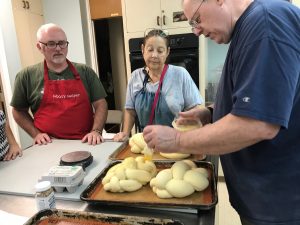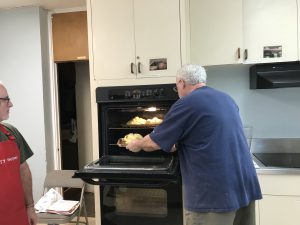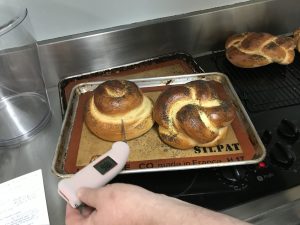Recipes from Peter Fritz
By Peter Fritz
Stress Baking
Jun 10, 2020
By Peter Fritz
Looking for a distraction that provides comfort? Try baking bread. When you are making bread, the only thing you are thinking about is your bread. You are not thinking about anything else. If you want to try baking bread, but lack confidence, try this no knead bread from Mark Bittman of the New York Times. True to its name, no-knead bread doesn’t require any kneading. It’s pretty foolproof, yielding a low-rise loaf with minimal effort and equipment.
The YouTube video promises it will not go wrong.
While waiting for everything to be figured out and start to return to normal, at least you will have bread. Give it a try.
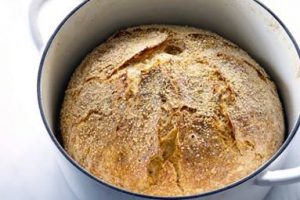
Here’s the recipe:
Speedy No-Knead Bread
Yield 1 big loaf
Time 45 minutes, plus 4 1/2 hours’ rising
Ingredients
- 3 cups bread flour
- 1 packet (1/4 ounce) instant yeast
- 1 ½ teaspoons salt
- Oil as needed
Preparation
- Combine flour, yeast and salt in a large bowl. Add 1&1/2 cups water and stir until blended; dough will be shaggy. Cover bowl with plastic wrap. Let dough rest about 4 hours at warm room temperature, about 70 degrees.
- Lightly oil a work surface and place dough on it; fold dough over on itself once or twice. Cover loosely with plastic wrap and let rest 30 minutes more.
- At least a half-hour before dough is ready, heat oven to 450 degrees. Put a 6-to-8-quart heavy covered pot (cast iron, enamel, Pyrex or ceramic) in oven as it heats. When dough is ready, carefully remove pot from oven. Slide your hand under dough and put it into pot, seam side up. Shake pan once or twice if dough is unevenly distributed; it will straighten out as it bakes.
- Cover with lid and bake 30 minutes, then remove lid and bake another 15 to 30 minutes, until loaf is beautifully browned. Cool on a rack.
Hallaq (Persian Charoset)
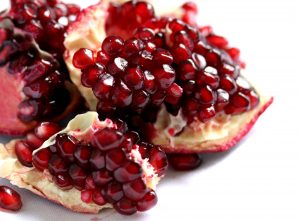
Looking for a change from the apple, walnut and cinnamon charoset? Try hallaq, Persian charoset. Hallaq symbolizes the Jewish Exodus from Egypt and highlights some of the sweet and warm flavors from Iran such as raisins, dates and pomegranates. A wide variety of nuts is also used throughout Persian cooking, as reflected in the four types used here. Unlike sweet Ashkenazi haroset, this recipe adds a taste of cider vinegar and some fresh ginger, very typical of the savory-sweet combination found in Persian cooking. Shaping the haroset into a pyramid, as is traditional, is a lot of fun and looks perfect on any seder table.
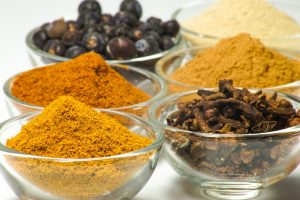
Ingredients
1 cup almonds
1 cup roasted, shelled pistachios
1 cup walnuts
1 cup black raisins
1 cup golden raisins
1 cup dates, pitted
2 teaspoons cinnamon
2 teaspoons ground cardamom
1 teaspoon ground ginger
½ teaspoon ground nutmeg
1 large apple, peeled, quartered and cored
1 large pear, peeled, quartered and cored
2 bananas, peeled
2 to 3 tablespoons cider vinegar
½ to 1 cup pomegranate juice
½ to 1 cup sweet kosher wine.
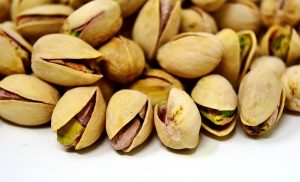
Directions
- In a large food processor, combine nuts, raisins, dates and spices. Pulse until nuts are coarsely chopped.
- Add apple, pear and bananas, and pulse until coarsely chop. Add 2 tablespoons vinegar, 1/2 cup pomegranate juice, and 1/2 cup wine. Pulse again, adding more vinegar, juice or wine to taste, as needed to make a coarse paste. Do not purée; mixture should retain some crunch.
Yield: 6 cups.
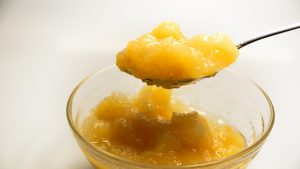
T”U B’Shevat Challah
When Dina asked for contributions for the T’U B’Shevat seder, I offered to make the challot. Dina mentioned the Biblical “seven species” that represent the fruits of Eretz Yisrael and I adapted two recipes to use four; wheat, figs, olives (olive oil) and dates (date syrup). This recipe will make two loaves.
T”U B’Shevat Challah (Two Loaves)
Ingredients
|
Directions
- Toast walnuts in an oven or under the broiler. Set aside to cool. Measure 1½ cups of the toasted walnuts, place in a food processor with 2 tablespoons of the whole-wheat flour and process until finely ground and add to the whole-wheat flour. Cut figs into smaller
- In the bowl of a standing mixer, dissolve yeast and 1 tablespoon date syrup in 2 cups of lukewarm
- Using the paddle attachment, stir oil into yeast mixture, then add 2 eggs, 1 at a time, and date syrup and salt. Switch to the dough hook and gradually add flour, kneading for about 5 minutes and adding more flour as needed to make a slightly sticky, smooth and elastic Then add figs to be kneaded into the dough.
- Grease the bowl and brush the dough with Cover the bowl with plastic wrap and let the dough rise in a warm place for approximately 1½ to two hours, until the dough doubles in volume.
- Separate challah
- Knead dough for a few moments and form Place challahs in a warm place and let rise again. Preheat oven to 350° F.
- In a small bowl beat the egg with 1 teaspoon of water. Brush the challahs with the mixture and sprinkle with sesame seeds. Bake for approximately 45 minutes or until the loaves turn golden brown. I recommend spot checking the bread using a fast reading thermometer after 26 minutes and baking a little longer so that the internal temperature of the loaves is 190–200°F. This internal temperature should yield a bread that is cooked through and not gummy in the center but is still moist and tasty.
High Holy Days Challah
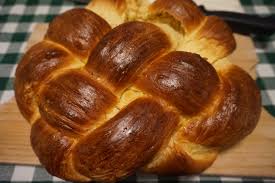
All year long our challah is braided, but it is round for Rosh Hashanah. What does the challah’s shape teach us about this special time of year?
There are many explanations. Round challahs have no end, symbolizing (and actualizing) our wish for a year in which life and blessings continue without end. Round challahs represent the circle of life and mark the cyclical nature of the passage of a year, a reflection of the continuing cycle of years and seasons. Togetherness, a hugging circular grip comes to mind. When I connect the end of a braid to the beginning, I think of it as symbolizing the end of one year flowing into the beginning of a new year.
During this time, we are to be introspective, looking back as we plan ahead, taking stock of all that has transpired and endeavoring to make resolutions to continue to better ourselves as human beings. Our thoughts turn to repentance and self-improvement, the round challah reminds us that the opportunity for teshuvah, return, is never-ending.
Date, Walnut, Silan, and Sesame Challah
The round, braided challahs of the Jewish High Holidays are special, and filling the strands of those braids makes them even more so. Here, the combination of plump Medjool dates, date molasses and walnuts makes a filling that is rich and surprisingly not too sweet. Use other nuts if you like, but we think this flavor trio — graced with nutty-tasting sesame on top — is a winner.
If you have a 9 1/2-to-10-inch springform pan, use it to bake this challah; it will help keep the bread’s shape.
Make Ahead: The dough needs to proof twice: first for 1 hour, and again for 30 to 40 minutes after the dough has been filled, braided and shaped into a pan. The baked challah can be wrapped in aluminum foil, then plastic wrap, and frozen for up to 1 month. To reheat, discard the plastic wrap but keep the bread wrapped in foil; warm through in a 350-degree oven for 10 to 15 minutes.
Where to Buy: Silan, often labeled date molasses, is available in Mediterranean markets. You can find roasted sesame seeds in the international aisle (Asian section) of large grocery stores.
Ingredients
For the challah
- 1 cup lukewarm filtered water, plus 1/2 to 1 cup filtered water
- 1/2 cup sugar
- 3 packets (3/4 ounce) active dry yeast
- 34 ounces (scant 8 cups) all-purpose flour, plus more for the work surface
- 3 teaspoons kosher salt
- 1/2 cup canola oil, plus more for proofing
- 4 teaspoons date molasses (silan; see headnote)
- 2 large eggs, plus 2 large eggs for the egg wash
- Roasted sesame seeds, for garnish
For the filling
- 16 tablespoons silan
- About 6 ounces walnut halves, chopped (2 scant cups)
- About 12 ounces Medjool dates, pitted and chopped into 1/2-inch pieces (2 packed cups)
Directions
For the challah: Whisk together the lukewarm water, 1/2 teaspoon of the sugar and all the yeast in a liquid measuring cup. Cover tightly with plastic wrap; let stand for about 20 minutes, until a head of bubbles forms and the mixture increases in volume.
Combine the flours, the remaining sugar and the salt in the bowl of a stand mixer fitted with a dough-hook attachment; beat on low speed for about 10 seconds, then add the yeast mixture, the 1/4 cup of oil, the silan and 1 egg. Gradually add the remaining 1/4 to 1/2 cup water (as needed); the dough will seem a bit wet, initially. Beat for 10 minutes (low), during which time the dough will firm up and become elastic; stop once or twice to work the dough down the hook as needed.
Use some oil to lightly grease a proofing bowl. Transfer the dough to the bowl, making sure to turn the dough so it’s evenly coated, cover with plastic wrap and set in a non-drafty place for 1 hour or until the dough doubles in volume.
Lightly flour a work surface. Uncover the dough and plop it out onto the surface. Use a bench scraper or large knife to divide the dough into 4 equal portions. Working with one at a time, roll out each portion to a rectangle that’s about 12 inches long and 8 inches wide, checking to make sure it isn’t sticking to the surface.
Filling: Spread 2 tablespoons of silan evenly over each rectangle of dough, leaving a 1/2-inch margin at the edges. Scatter one-quarter each of the chopped dates and walnuts evenly over the silan. Starting with the long edge of the dough that’s closest to you, tuck and roll the dough, making sure to blend in the seam at the end. The 4 filled rolls of dough should be the same length and of even thickness, so adjust them as needed.
Line the springform pan or a baking sheet with parchment paper.
To braid the dough, think woven tic-tac-toe grid or hashtag as the first step.
Place 2 filled-dough ropes horizontally (parallel with the edge of the countertop) with no more than 1/2 inch between them. Place a third filled rope of dough perpendicular toward the middle of the pair of horizontal ropes. Weave it over the top horizontal rope and under the other horizontal rope. Place the fourth filled rope parallel and to the left of the third rope with 1/2-inch space between; weave it under the top horizontal strand and over the bottom horizontal strand. That should create the desired hashtag pattern, with the remaining ropes extending beyond it.
Working clockwise, bring the under rope of dough (in each pair) over the next one. Then, working counterclockwise, do the same, with each next pair of ropes. Bring the rope that is in the “under” position up and over the next rope that is in the “over” position. Pinch each new pair of rope ends and twist; tuck them underneath the now-round, braided challah while cupping the dough with your hands to plump up the braids and finesse the round shape.
Support the underside of the woven round as you transfer the dough to the pan or baking sheet. Tuck and shape it in the pan as needed. Cover with a clean dish towel; let it proof in a non-drafty place for 30 to 40 minutes. Do not over proof, or the shape of the challah may be adversely affected.
Meanwhile, preheat the oven to 350 degrees. (If you like, set the proofing pan of dough atop the range while the oven preheats below.)
Once the dough has proofed a second time, beat the remaining egg well in a liquid measuring cup. Brush the top of the dough with the beaten egg, making sure not to let the egg drip down the sides (or the bread may stick to the sides of the pan), then immediately scatter the roasted sesame seeds over the top.
Bake (middle rack) for 50 minutes or until nicely browned and fragrant, rotating the bread from front to back about halfway through the baking time. Transfer the pan to a wire cooling rack; let cool for 20 to 30 minutes before removing the pan’s springform ring and bottom (if using). Cool the bread completely (keeping it on its parchment) before serving or storing.
The Meaning of Each Braid
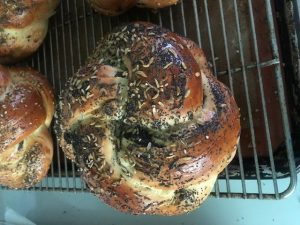 Recently, I made several braided round challahs. Some people may have wondered why. After all, it is not Rosh Hashanah. I often make round braided challahs for events like bar/bat mitzvahs, baby naming and weddings because it incorporates the spirit and life of the event. A round challah starts off looking like a tic-tac-toe grid with the two vertical and two horizontal braids of bread. Each braid represents part of the event, but there is little contact between the straight braids of dough. As I braid the bread, I think about the people that will come together for the event. For a baby naming, one braid could be for the child, a second for the parents and family, a third for the community that is present, and a fourth for the community that welcomes and embraces the child. The meaning of each braid will incorporate the spirit of the event. All of these elements are woven together and provide support to each other, transforming a plain grid into a circle of life. So when you see a round braided challah, think about all the important things that came together and the support that comes from the parts. It is true, the whole is greater than the sum of the parts. This is what the Sof Ma’arav Community is all about.
Recently, I made several braided round challahs. Some people may have wondered why. After all, it is not Rosh Hashanah. I often make round braided challahs for events like bar/bat mitzvahs, baby naming and weddings because it incorporates the spirit and life of the event. A round challah starts off looking like a tic-tac-toe grid with the two vertical and two horizontal braids of bread. Each braid represents part of the event, but there is little contact between the straight braids of dough. As I braid the bread, I think about the people that will come together for the event. For a baby naming, one braid could be for the child, a second for the parents and family, a third for the community that is present, and a fourth for the community that welcomes and embraces the child. The meaning of each braid will incorporate the spirit of the event. All of these elements are woven together and provide support to each other, transforming a plain grid into a circle of life. So when you see a round braided challah, think about all the important things that came together and the support that comes from the parts. It is true, the whole is greater than the sum of the parts. This is what the Sof Ma’arav Community is all about.
Challah: Flour Power
Bread – Yeast is Grumpy, Temperature Is Key
Temperature in preparation/mixing
Though it may not seem like it, the temperature at which you mix your dough can have a significant effect on the outcome of your bread. The temperature at which your yeast blooms can affect the flavor of your bread. Yeast reactivates best between 110°F and 130°F (43°C and 54°C). But push the activation temp above 140°F (60°C) and you’ll kill the yeast before it can even wake up.
At the same time, if you use water below 105°F (41°C) to wake it up, the yeast will wake up grumpy and you’ll get off-flavors in your bread. You know how bad it is to take a cold shower in the morning when you wanted a hot one, and yeast feels the same!
To what temperature do I cook bread?
It has been handed down to us that a bread loaf is done when it produces a “hollow thump” when tapped on the bottom. Humbug. Most people don’t think about it, but there are varying temperatures for bread doneness, just like there are for beef.
For lean-dough breads the recommended doneness is 190–210°F (88–99°C), while rich-dough breads are done at 180–190°F (82–88°C). These critical temps are important if you want bread that is cooked through and not gummy in the center but is still moist and tasty.
Resizing loaves from a recipe will mean a change in cooking time, but it will not mean a change in internal temperature requirements. If you make a bigger loaf, rest assured it is not doughy in the middle by monitoring that internal temperature!
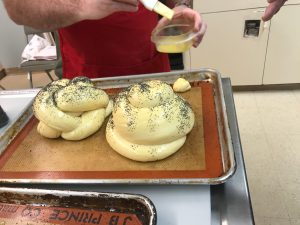
Olive Oil Matzo
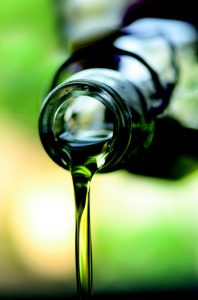
Time:
30 minutes, mostly unattended
2 cups flour
1/2 teaspoon salt
1/3 cup olive oil
1/2 cup water
Sea salt, optional.
Yield: 12 servings.
- Heat the oven to 500 degrees. Put flour, salt and olive oil in a food processor. Once the machine is on, add water. Continue to run the machine until the dough forms a firm ball, rides around on the blade and is not at all sticky. (If you prefer, whisk together the water and oil and add this to the machine all at once.)
- Cut the dough into 12 small balls — this is easiest if you cut the ball in half, then half again, then into thirds — and flatten each into a 3- to 4-inch patty. On a well-floured surface, use a rolling pin to roll each patty into a 6- to 8-inch circle. The shapes can be irregular, but the dough should be so thin you can almost see through it.
- Put the dough on ungreased cookie sheets, sprinkle with sea salt if you like, and bake for about 2 to 3 minutes, keeping a very close eye on the breads — they can burn very quickly. Once they begin to puff up and brown, flip and cook for another minute or so on the second side. Repeat with all the dough and let cool completely.
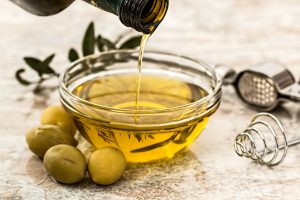
Fennel and Orange-Scented Challah Recipe
Fennel and orange scented challah is a favorite of many members of the congregation. Because fennel and orange go so well together, I include some orange zest with some fresh orange juice in the dough for its scent and brightness. The added flavor and natural sweetness from the orange allows for a reduction in the amount of sugar.
Ingredients
- 1 tablespoon plus 1/3 cup sugar or honey.
- Grated zest from 2 large oranges plus 1/2 cup of the juice, strained
- ⅓ cup vegetable or canola oil
- 3 large eggs, plus 1 egg yolk
- 1 tablespoon salt
- 7 ½ cups unbleached all-purpose flour, plus more as needed
- 1 tablespoon fennel seeds
- 2 teaspoons poppy seeds
- 2 teaspoons roasted sesame seeds
Preparation
-
- In the bowl of a standing mixer, dissolve yeast and 1 tablespoon sugar in 1 cup of lukewarm water.
- Using the paddle attachment, stir orange zest, juice and oil into yeast mixture, then add 2 eggs, 1 at a time, and remaining sugar and salt. Switch to the dough hook and gradually add 6 cups of flour, kneading for about 5 minutes and adding more flour as needed to make a slightly sticky, smooth and elastic dough.
- Grease a large bowl, turn dough into it and then turn the dough over to grease the top. Cover with greased plastic wrap and let rise in a warm place for 1 hour.
- When the dough has almost doubled, punch it down, divide it in half and braid the loaves.
- Beat remaining egg and egg yolk and brush about half the mixture on the loaves. Let rise uncovered another half-hour.
- Heat oven to 350 degrees and in a small bowl, combine fennel, poppy and sesame seeds. Brush the loaves with egg again and sprinkle with seeds.
- Bake for 35 to 40 minutes or until golden and firm when tapped with a spatula. Cool on a rack. I do not rely on time alone to determine when bread is done. I also use a thermometer to determine when the bread is done. A thermometer helps me to bake a bread that is cooked through, not gummy in the center and moist. There are varying temperatures for bread doneness, just like there are for a roast beef. For lean dough breads the recommended doneness is 190–210°F, while rich-dough breads like eggy challahs are done at 180–190°F. A thermometer also helps me when I make larger or smaller loaves. When I make smaller loaves, I need to adjust for a shorter cooking time, but the internal temperature stays the same. If I make a larger loaf, monitoring the internal temperature helps me to make sure that it is not doughy in the middle.
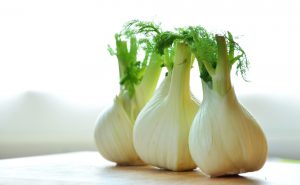
How to Braid a Six-Strand Challah Bread Loaf
A six-strand challah creates a thick, wide challah with a pretty design. However, I found the instructions hard to follow until I discovered simplified instructions on the Internet. All you have to remember is “over two, under one, over two.” Saying it out loud as you braid keeps you on track.
Step 1
Create six equal balls of dough. Roll each ball to create six equal strands. Taper your strands at both ends so they are thick in the middle and thin at the ends. Strive for 12-inch strands.
Step 2
Pinch the six strands together at one tapered end. Spread out the attached strands of dough on your work surface. Lift the far left or right strand to begin weaving.
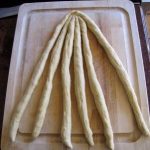
Step 2
Step 3
Weave the strand over the next two strands. Lift the third strand with your free hand and pull the weaving strand under it. Keep the weaving strand in your hand and take it over the next two strands of dough. Tighten up your loaf by pulling the fifth strand into the weave before you put down your weaving strand. Place your weaving strand of dough on your work surface.
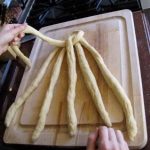
Step 3
Step 4
Weave the challah strands again by using the strand now on the outer edge of the attached six strands of challah dough. Start from the same direction throughout the weaving process. Repeat Step 3 until you have woven the entire length of challah dough.
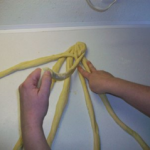
Step 4
Step 5
Pinch the tapered ends of the challah loaf to secure the weave. Tuck both pinched ends under the loaf of bread. If your loaf seems too long and skinny, you will need to “plump” it a little to create a more stout loaf shape. Simply place your rounded hands at each end of the braid and gently push the two ends toward each other.
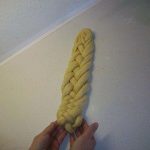
Step 5
Step 6
Place the woven loaf on a baking sheet. Allow the challah to rise for 30 minutes before baking.
The instructions for making a four-strand challah are similar. All you have to remember is “over one, under one, over one.”
Sephardic Challah With Whole Spices
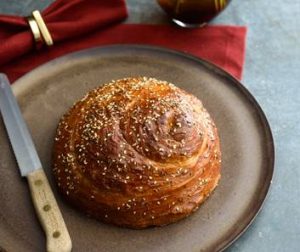 I enjoy baking different types of challahs for Sof, and this is a favorite. While this recipe suggests a variety of spices, the seeds used for Sof are a combination of anise, coriander, and sesame seeds. I confess that I often use more honey and raisins that are called for in the recipe. Feel free to give it a try.
I enjoy baking different types of challahs for Sof, and this is a favorite. While this recipe suggests a variety of spices, the seeds used for Sof are a combination of anise, coriander, and sesame seeds. I confess that I often use more honey and raisins that are called for in the recipe. Feel free to give it a try.
Sephardic Challah With Whole Spices
Challah is tremendously popular in the United States, among Jews and non-Jews alike. But it doesn’t say anywhere in Jewish scripture that challah is a braided, sweet, eggy, deliciously squishy bread of the kind familiar to most Americans. That loaf is Ashkenazi, from Eastern European Jews. The Sephardic and Mizrahi Jews (from North Africa) and the Middle East, have their own distinct traditional loaves. There, they use the raisins, eggs, and a full amount of honey to make a richer, festive Sephardic loaf that is delicious by itself. Leave it out for a lean, savory Mizrahi bread that goes beautifully with Moroccan tagines and Middle Eastern mezes, salads, and dips. From the NY Times https://cooking.nytimes.com/recipes/1017858-sephardic-challah-with-whole-spices
Ingredients
- ½ cup/75 grams raisins, dark or golden or a combination (optional)
- 1 tablespoon/10 grams plus 3 tablespoons/30 grams sesame seeds
- 1 tablespoon/10 grams caraway or coriander seeds
- 1 tablespoon/10 grams anise, cumin or poppy seeds
- 1 envelope/7 grams active dry yeast
- 5 cups/600 grams bread flour, more for dusting work surface
- 2 ½ tablespoons/30milliliters/30 grams extra-virgin olive oil, more for oiling bowl and pans
- 2 to 4 tablespoons/30 to 60 grams honey (depending on how sweet you like your challah)
- 2 eggs, at room temperature (optional)
- 1 tablespoon/16 grams kosher salt
- Cornmeal, for dusting
- 2 egg yolks
Preparation
- If using, cover raisins in 2 cups/500 milliliters warm water and let plump for 30 minutes. Drain well and set aside.
- In a skillet, toast 1 tablespoon sesame, the caraway and the anise or other seeds over moderate heat until fragrant, 2 minutes. Transfer to a plate and let cool.
- In a small bowl, combine yeast with 2 tablespoons warm water (you can use the soaking water from the raisins if handy). Let stand until thoroughly moistened, about 5 minutes.
- In the bowl of a standing electric mixer fitted with the dough hook, combine flour with olive oil, honey, eggs (if using) and warm water (3/4 cup/120 milliliters if using eggs; 1 1/2 cups/360 milliliters if not).
- Mix at low speed until a very soft dough forms. If it is stiff, add warm water a tablespoon at a time. Add salt, yeast mixture and toasted seeds and mix at medium-low speed until the dough is supple and smooth, 10 minutes. Mix in raisins. Using oiled hands, transfer the dough to a large oiled bowl. Cover the bowl with plastic wrap and let stand in a draft-free spot until the dough is doubled in size, 1 1/2 to 2 hours.
- Lightly oil 2 small cookie sheets and dust them with cornmeal. Turn the dough out onto a lightly floured work surface and press to deflate. Cut the dough in half and let rest for 5 minutes. Roll each piece into an 18-inch-long rope and let rest for 5 minutes longer, then roll each rope into a 32-inch rope. Take 1 of the ropes and, starting from 1 end, form the dough into a coil; tuck the ends under the completed coil. Repeat with the remaining rope.
- Transfer each coil to a baking sheet and cover each loaf with a large inverted bowl. Let stand for 1 hour, until the loaves have nearly doubled in bulk. (The risen loaves can be frozen, wrapped, for up to 2 weeks; top and bake just before serving.)
- Heat oven to 400 degrees. In a bowl, whisk egg yolks with 1 tablespoon water. Brush the egg wash over the loaves and let stand uncovered for 30 minutes. Brush with the egg wash once more and sprinkle with the reserved sesame seeds. Bake the loaves side-by-side in the center of the oven for 30 minutes, until they’re golden and sound hollow when tapped on the bottom. Transfer the loaves to racks and let cool before serving or slicing.
Matzah Caramel Crunch Recipe
Matzoh Caramel Crunch
1 jelly roll pan
Matzoh to cover the bottom
2 sticks butter
1 cup brown sugar
½ cup chopped nuts
2 cups chocolate chips (or enough to cover the matzoh)
Preheat oven to 350*
Cover the jelly roll pan with foil. Spray with cooking spray. Lay
matzoh flat on the bottom of the pan, breaking it when necessary to
cover the entire bottom. Combine butter and sugar in a saucepan.
Bring to a boil for five minutes, stirring constantly. Pour the mixture
over the matzoh. Bake for 10-15 minutes, watching carefully to
prevent burning. Sprinkle the chocolate chips over the hot brittle.
Let the chocolate melt, and spread it out to cover the entire surface.
Top with chopped nuts. Drizzle a little chocolate over the nuts.
Refrigerate until it’s completely cool. Break into pieces, and store in
Tupperware.
Challah Class Fun
Apr 16, 2019
Taught by Peter Fritz
In this course, we make and bake eight challahs. The first part consists of mixing the ingredients to make the bread dough (approximately one hour). While the dough is rising, we discuss baking temperatures and different braiding techniques (approximately one hour). After the ball is risen, the dough will be divided and each person will braid their own loaf. After the braided loaves have risen, they will be baked. It is estimated that the total time to make the dough, braid the loaves and bake the loaves will be approximately 3 1/2 hours.

